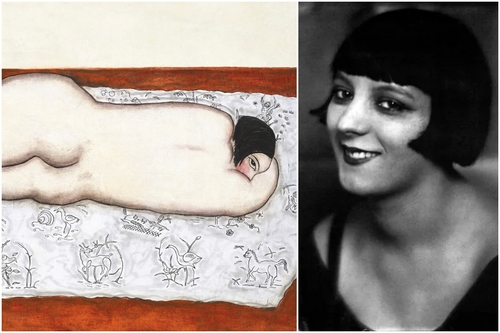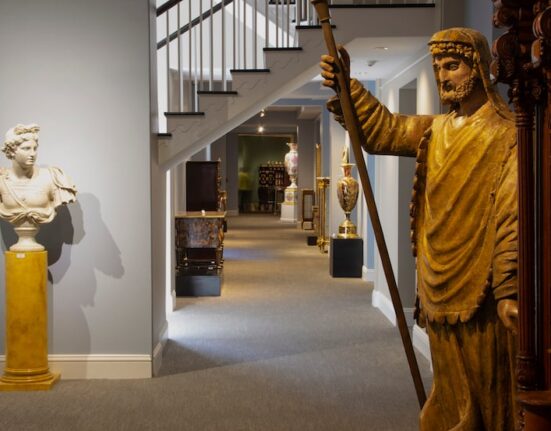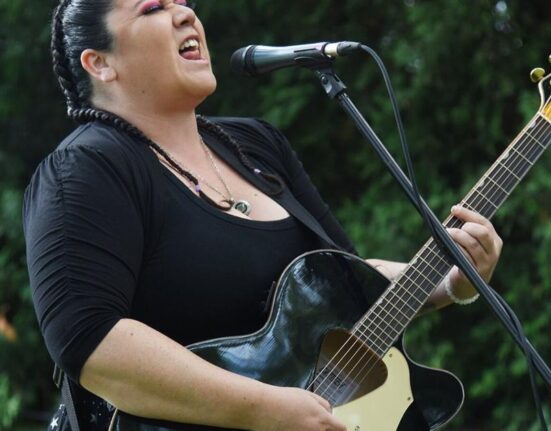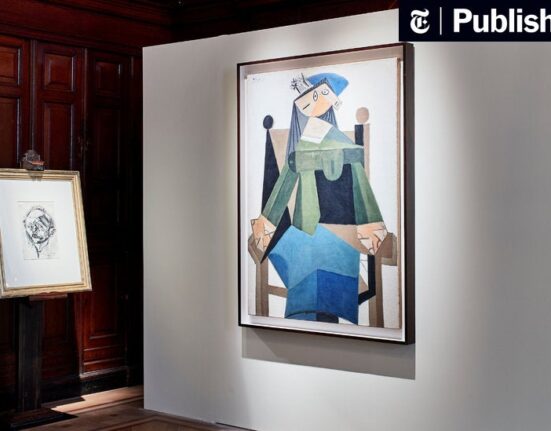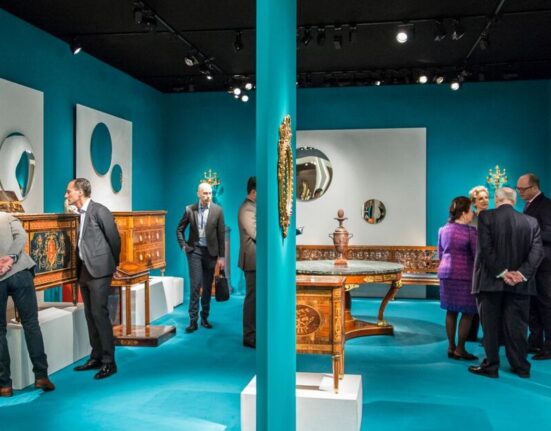The symbol of bohemian Paris during the “annees folles”, Alice Prin, more popular known as Kiki de Montparnasse, was an icon in the 1920s Montparnasse social scene. Passionate and sometimes intense, the dazzling muse held everyone in the Parisian art circles spellbound: nearly all celebrated male artists of the time have left behind trademark paintings featuring the charming and talented model.
Last year, Man Ray’s original copy of Le Violon d’Ingres, one of the most famous images of her and of Surrealist photography, stirred waves in the market as it sold for a staggering US$12.4 million at Christie’s New York, making history as the most expensive photograph ever sold at auction.
This season, Christie’s brings to Hong Kong another portrait of the Queen of Montparnasse – Nude on Tapestry by Sanyu (1895-1966), the Chinese-French artist who is hailed as Chinese Matisse. Executed in 1929, it is also the master’s first major nude painting, depicting the French beauty through an East-meets-West eye.
Fresh-to-market, it carries an estimate between US$13 and 20 million and will lead the house’s 20th/21st Century Art Evening Sale on 28 November.
Man Ray’s photographic image of Kiki de Montparnasse set an auction record for a photo at US$12.4 million at Christie’s New York in 2022
Lot 11 | Sanyu (1895-1966) | Femme nue sur un tapis (Nude on Tapestry), Oil on canvas
Painted in 1929
81 x 130 cm
Provenance:
- Henri-Pierre Roché, Paris
- Jean-Claude Riedel, Paris
- Acquired from the above by the present owner
- The Dreyfus collection
Estimate: HK$100,000,000 – 150,000,000 (US$13 – 20 million)
Auction House: Christie’s Hong Kong
Sale: 20th/21st Century Art Evening Sale
Date and Time: 28 November 2023 | 7:00 pm (Hong Kong Local Time)
Kiki was born in 1901 to a single-parent family in a small town in France and moved to Paris alone to study at the age of twelve. A few years later, she began her career as a model for various artists.
By befriending the artist Soutine, she made her way into the inner circle of Montparnasse. Instantly recognizable by her signature bobbed hair, this woman of multiple interests – a model, singer, actor, painter, and writer – thrust herself into the limelight of the Bohemian art scene and made a name for herself.
Soon, she played muse to many leading male artists in the city, including Alexander Calder, Amedeo Modigliani, Tsuguharu Foujita, and May Ray – it is no exaggeration to say she was partly the reason for their success.
With her being a wildly sought-after professional model at the time, it came naturally that Sanyu, then a carefree art student in Montparnasse, was captivated by her allure as well.
Unlike any other depictions of the Queen of Montparnasse, Nude on Tapestry (1929) sees the Chinese-French master dress her in a robust body with varied brushwork and suggestions of ink-wash techniques, her nude form akin to a range of undulating hills, demonstrating the artist’s unique modern style underlying a deep understanding of traditional Chinese landscape paintings.
Alice Prin, or Kiki de Montparnasse, played muse to nearly all the leading male avant-garde artists in Paris at the time
Details of the present lot
Sanyu (right) and his friend in Paris
Born in Sichuan during the late 19th century, Sanyu was the doted-on youngest child in an affluent family which owned one of the largest silk-weaving mills in the region. As a kid, his love for art was fully supported by his parents, who arranged for him to home-school lessons with a skilled calligrapher.
Alongside a wave of young Chinese artists who took advantage of a government-sponsored work-study program, Sanyu arrived in Paris in 1921. With economic support from his family, he was unfettered by financial concerns, nor concerned with the pursuit of fame, leading the bohemian life of a Parisian artist.
What the blithe artist did not know then was that his life would go downhill in years to come. In the 1930s, when his brother died, his only reliable source of income also ended. With war ravaging Europe in the years that followed, he only fell into even more dire straits. At his lowest point, he could not even afford to buy art supplies, which also explained the scarcity of his works, with only around three hundred oil paintings in his entire oeuvre.
Sanyu’s depiction of studying at the Académie de la Grande Chaumière | L’Atelier, pose du modèle (1930s) | Sold: HK$5.1 million, Christie’s Hong Kong, 2013
Sanyu’s final masterpiece on the female nude shows his skilful use of freehand lines | Nu (1965), Sold: HK$198 million, Sotheby’s Hong Kong, 2019
Back in the 1920s, life was easy for Sanyu: he attended classes at the liberal Académie de la Grande Chaumière in Montparnasse, whiled away his afternoons in the coffee houses where artists and writers lingered, and brushed shoulders with European creative luminaries such as Alberto Giacometti.
Fully absorbed in the swirling atmosphere of the vibrant art scene, Sanyu, like other modern artists, began to freely explore the genre of the female nude – a classic subject in Western art since antiquity, but one that was never considered appropriate in Chinese fine art, appearing only in low-class erotic images reserved for entertainment only.
As an artist exposed to Confucianism and traditional Chinese aesthetics from a young age, he conceptualised the subject matter in a completely new light. Using Western oil paints, Sanyu treated the female form almost like a landscape, with the body curves, especially those “cosmic thighs” – as the celebrated Chinese poet Xu Zhimo coined – reminiscent of sweeping mountain ranges of Chinese paintings.
Best recognized by his masterful use of calligraphic, freehand lines, the artist sought to “simplify, and then further simplify” his strokes, a concept adopted from traditional Chinese art. And in outlining his subject’s form in concise, sinuous black lines, he brings the female nude vividly to life.
Sanyu | Five Nudes (1950-1959), | Sold: HK$303,985,000, Christie’s Hong Kong, 2019 (Auction record for the artist)
The present lot
Details of the present lot | The tapestry is filled with an array of Chinese auspicious symbols
Here, in merely a few strokes, the artist has successfully sketched out Kiki’s iconic hairstyle, which is the only clue to identifying the mysterious subject.
Imbued with a poetic Oriental flair, the present piece portrays the charming muse reclining on a tapestry, depicted using classic line drawing methods from Chinese ink painting.
It is in and of itself a work of art filled with an array of Chinese auspicious symbols and riddles. Deer, pronounced lu in Chinese, is a homophone for social status; egret is a rebus for continuous success; the Chinese rose is a symbol of longevity; the fight between the snipe and the clam is a well-known folklore.
This piece of tapestry recurs multiple times in Sanyu’s oil paintings of nudes from the 1930s, including the Nu rose sur tissus chinois that sold for US$6.4 million in 2019, so it was likely an actual object that the artist owned.
There is also a “sister painting” to the present canvas, titled Nude and created later than this present lot, which shares the exact same composition as Nude on Tapestry, but it is much smaller in size and without the tapestry.
Sanyu | Nu rose sur tissus chinois (1930s), 45.2 x 81.2 cm | Sold: HK$49.9 million, Sotheby’s Hong Kong, 2019
Sanyu | Nude (c. 1930), 27 x 46 cm | Exhibited in Lin & Lin Gallery in Taipei in 2018
Nude on Tapestry was selected as the front cover image for The Complete Works of Sanyu Oil Paintings (Volume I)
Among the three hundred oil paintings Sanyu created, only fifty-six of them depict the female nude. By the 1930s, right before the Great Depression hit Paris, Sanyu had created thirteen oil paintings of a reclining nude, and only five of them portray the figure with her back against the viewer, making the present piece truly a rarity in his oeuvre.
Adding to the present lot’s significance, it was selected as the front cover image for The Complete Works of Sanyu Oil Paintings (Volume I), arguably the most historically important publication on the artist.
After Nude on Tapestry was created, it was acquired directly by the renowned collector-dealer Henri-Pierre Roché, who represented Sanyu from 1929 to 1932. It later entered the hands of Jean-Claude Riedel, another important Parisian dealer and collector, and a major proponent of Sanyu’s works, before going into the Dreyfus Collection in Paris, where it has resided privately ever since.

